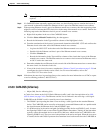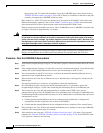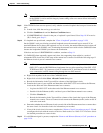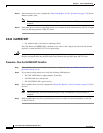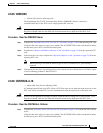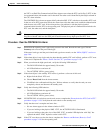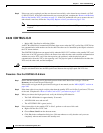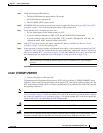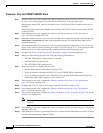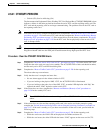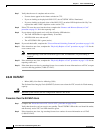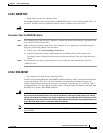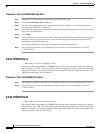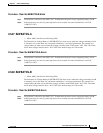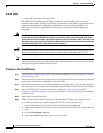
2-41
Cisco ONS 15327 Troubleshooting Guide, R3.4
March 2004
Chapter 2 Alarm Troubleshooting
Alarm Procedures
Step 5 Verify the following LED behavior:
• The FAIL LED blinks for approximately 30 seconds.
• All LEDs blink once and turn off.
• The ACT/STBY LED is green (active).
Step 6 If CONTBUS-IO-B is raised on several cards at once, complete the “Reset the Active XTC Card in CTC”
procedure on page 2-129. Verify that the card reboots as the standby card.
Step 7 Verify that the reset is complete and error-free:
• No new alarms appear in the Alarms window in CTC.
• If you are looking at the physical ONS 15327, the ACT/STBY LED is illuminated.
• If you are looking at the node view of the ONS 15327, an amber LED depiction with “Sby” has
replaced the white “LDG” depiction on the card in CTC.
Step 8 If the CTC reset does not clear the alarm, complete the “Remove and Reinsert (Reseat) a Card”
procedure on page 2-130 for the reporting card.
Step 9 If the reset card or replaced card has not rebooted successfully, or the alarm has not cleared, call TAC
(1-800-553-2447). If the TAC technician tells you to reseat the card, complete the “Remove and Reinsert
(Reseat) the Standby XTC” procedure on page 3-3. If the TAC technician tells you to remove the card
and reinstall a new one, follow the “Physically Replace a Card” procedure on page 2-130.
Note When replacing a card with an identical type of card, no additional CTC provisioning is
required.
2.6.40 CTNEQPT-PBPROT
• Critical (CR), Service Affecting (SA)
The Interconnection Equipment Failure Protect XTC Card Payload Bus (CTNEQPT-PBPROT) alarm
indicates a failure of the main payload between the protect XTC card and the reporting traffic card. The
XTC card and the reporting card are no longer communicating. The problem exists in the XTC card and
the reporting traffic card.
Note If all traffic cards show CTNEQPT-PBPROT alarm, complete the “Remove and Reinsert (Reseat) a
Card” procedure on page 2-130 for the standby XTC card. If the reseat fails to clear the alarm, complete
the “Physically Replace a Card” procedure on page 2-130 for the standby XTC card. Do not physically
reseat an active XTC card. Reseating the XTC disrupts traffic.
Caution It can take up to 30 minutes for software to be updated on a standby XTC card.
Caution Always use the supplied electrostatic discharge wristband when working with a powered ONS 15327.
Plug the wristband cable into the ESD jack located between the top high-speed and XTC slots.



